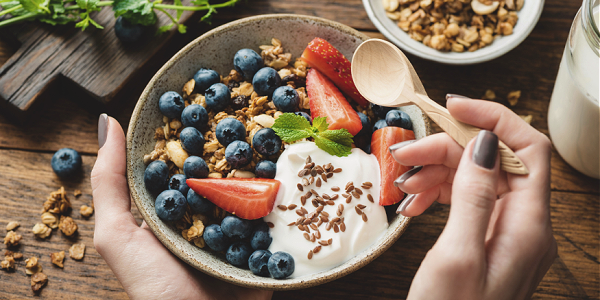
Spoiler alert: There’s no universal Ozempic diet plan—and that’s a good thing!
An eating plan should best suit you, as some recommended foods to avoid on Ozempic may actually be on your personal menu. Regardless, understanding which foods you may need to avoid or eat more can make all the difference in how you feel and your weight loss success: certain dietary choices can interfere with these benefits or cause discomfort.
Our dietitian team details which foods you may reconsider on Ozempic so you can optimize best managing your weight, side effects, and overall well-being. Let’s get into it!
What Is Ozempic?
Ozempic, a once-weekly injectable, belongs to a class of medications known as glucagon-like-peptide-1 (GLP-1) agonists. It’s used to manage blood sugar levels in people with type 2 diabetes and, in some cases, obesity.
The Food and Drug Administration (FDA) approved Ozempic in 2017 to lower blood sugar levels in adults with type 2 diabetes. It’s also approved to reduce the risk of major cardiovascular events—such as heart attack, stroke, and death—in adults with type 2 diabetes with known heart disease.
With this approval, however, so were the recommendations to use alongside diet and exercise. Although there are plenty of foods to eat on an Ozempic diet plan, a few should be reconsidered to mitigate side effects and leverage your weight loss success.
Better understanding how Ozempic works can help you better understand why certain foods should be avoided or limited.
How Does Ozempic Work?
Ozempic mimics the hormone glucagon-like peptide-1 to balance blood glucose levels. Here’s a brief overview of how Ozempic works.
Stimulates Insulin Secretion
Ozempic promotes the release of insulin, a hormone produced in the pancreas, to help glucose move from the bloodstream and into cells for energy. This, in turn, helps lower blood sugar levels.
Lowers Glucagon Secretion
In contrast to insulin, glucagon increases blood sugar levels by converting glycogen (stored glucose) into available glucose. Glucagon is often secreted excessively in people with diabetes, and Ozempic reduces this secretion to help stabilize blood sugar.
Delays Gastric Emptying
By slowing stomach emptying, Ozempic manages appetite, weight, and blood sugar levels after meals.
Although these mechanisms can improve health outcomes and quality of life for Ozempic users, avoiding or limiting certain foods can unlock these life-changing benefits.
Overview: What’s An Ozempic Diet Plan?
An Ozempic diet embodies nutritional guidelines and habits to support individuals while taking the medication. It aims to manage potential side effects, enhance its effectiveness, and promote overall health for long-term success.
Potential foods to avoid and emphasize can help you accomplish these goals, but an Ozempic diet is not one-size-fits-all. You should ideally work with your healthcare team and experiment with what works for you, as potential foods that may exacerbate digestive distress—like broccoli and other high-fiber foods—are nutritious choices that you may tolerate.
Foods to Avoid On Ozempic
Let’s first acknowledge that there aren’t foods you should totally avoid unless medically advised or personally-preferred, and you may need to experiment with trial and error to find what works best for you. However, limiting the following foods may help improve your experience and success on Ozempic.
High-Fat, Greasy and Fried Foods
Although we need fats in our diet, high-fat foods—especially greasy and fried foods—can exacerbate digestive symptoms like nausea and vomiting.
Plus, fried foods are laden with calories and often trans fats, which can challenge weight loss efforts, worsen diabetes, and increase the risk of heart disease.
High-fat foods to be mindful of include:
• Butter and oils
• Fattier meats, such as bacon and sausage
• Fried foods, including fried chicken and French fries
• Full-fat dairy products, such as whole milk, cream, and Greek yogurt
• High-fat cheeses
• Peanut and nut butters
If you want to enjoy these foods, we recommend monitoring your portion size, prioritizing more nutrient-dense sources (like Greek yogurt), and evaluating your tolerance.
Sugary Foods and Drinks
Yes, Ozempic helps reduce blood sugar levels but consuming sugary foods and drinks can counteract these benefits. High-sugar foods can cause blood sugar spikes and often supply little to no nutritional value while adding calories, making managing weight and diabetes hard.
Sugary foods and drinks include:
• Candies
• Condiments and sauces
• Fruit juices, including those without added sugars
• Ice cream and some yogurts
• Pop/soda
• Pastries and desserts, including cakes, cookies, and donuts
• Sports drinks, unless noted “sugar-free”
• Sugary breakfast cereals, including some flavored oatmeal varieties
Certain Fruits and Vegetables
Although fruits and vegetables can (and should) be part of a balanced diet, some choices might need to be moderated (and potentially avoided) when taking Ozempic.
Although naturally occurring sugars, certain fruits and starchy vegetables have a high glycemic index (GI) and may spike blood sugars. This isn’t to say to avoid them, but it’s smart to moderate their intake and balance with a protein source for blood sugar control.
Higher-glycemic fruits and veggies include:
• Bananas, particularly as they ripen
• Dried fruits, including dried cranberries and raisins
• Fruit juices
• Grapes
• Pineapple
• Potato varieties, like russet and sweet potatoes
• Watermelon
Especially if you know you have difficulty digesting cruciferous veggies, like broccoli and cauliflower, you may want to steer clear from them since they may exacerbate bloating and gas.
High-Sodium Foods
Consuming high-sodium foods can contribute to hypertension (high blood pressure), which is a common comorbidity in people with diabetes. Keeping your sodium intake in check helps maintain overall heart health.
Along with minimizing salt shaker use, be mindful of these foods that tend to be higher in sodium:
• Canned foods, including soups, beans, and vegetables
• Frozen foods
• Processed meats, like bacon, deli meats, and sausage
• Salty snacks, such as chips, crackers, and pretzels
Also review the Nutrition Facts label on the food product, looking for the amount of sodium. The American Heart Association recommends consuming no more than 2,300 milligrams (mg) of sodium daily, or 1,500 mg if managing a heart condition, but you should consult your doctor for individual guidance.
Refined Carbohydrates
Like sugary foods, refined carbohydrates can lead to an increase in blood glucose levels. These foods often have a high glycemic index and offer little fiber, which means they are digested and absorbed quickly, leading to rapid spikes in blood sugar.
Refined carbs are commonly found in:
• Most boxed cereals (think those sugary childhood favorites)
• White breads, including bagels
• White pasta
• White rice
Overall, it’s beneficial to consider the glycemic index when eating carbs—which rates carbs, including sugar—on a scale from 0 to 100. Opting for low glycemic index foods (GI of less than 55), such as whole grains, can help you avoid spikes in blood sugar.
Spicy Foods
If you have a history of acid reflux, spicy foods can exacerbate your symptoms. Since tolerance varies from person to person, you may need to experiment with spicy foods or avoid them entirely to prevent discomfort.
Large Meals
Large meals, even when nutritionally dense, can exacerbate digestive symptoms. This is because they occupy more space in the stomach and take longer to digest.
Alcohol
Drinking alcohol while on Ozempic can present several challenges. Primarily, alcohol provides empty calories and increases the risk of hypoglycemia (low blood sugar), cravings, and gastrointestinal side effects.
If you choose to drink, it’s important to do so in light to moderate amounts and closely monitor your blood sugar levels to manage these risks effectively.
Foods to Eat On Ozempic
Rest assured, there are plenty of delicious and nutritious foods you can enjoy while taking Ozempic! Although there’s no specific Ozempic diet, a nutrient-dense and balanced eating plan is ideal for managing weight and blood sugar levels effectively.
Evidence shows that while many weight loss diets can be successful, prioritizing high-quality foods in a calorie deficit promotes better health. (1) Besides, the ultimate goal is to manage weight and improve overall well-being.
As a general guideline, focus on consuming:
• Lean proteins
• Whole grains
• Low-glycemic fruits and vegetables
• Healthy fats
Let's delve into the best foods to eat on Ozempic.
Lean Proteins
A high-protein diet is an effective and safe strategy for losing weight and preserving muscle mass while in a calorie deficit, especially when protein intake is evenly distributed throughout the day. (2) Aim for about 1.6 grams of protein per kilogram (g/kg) of body weight to lose weight, with up to 2.0 g/kg being ideal for physically active individuals. (3)
For example, someone weighing 175 pounds, about 80 kilograms (divide weight in pounds by 2.2), should aim for 128 grams of protein daily. This can be distributed as 30 grams of protein at each of three meals (breakfast, lunch, and dinner) and 15 grams at two snacks. For reference, 4 ounces of meat provides about 30 grams of protein.
To minimize fat content and the potential side effects of medications like Ozempic, prioritize lean protein sources such as:
• Beans and lentils
• Chicken breast
• Eggs, especially egg whites
• Fish and seafood, such as shrimp and tuna
• Ground turkey
• Low-fat dairy products, such as cottage cheese, Greek yogurt, and milk
• Low-sodium deli meats, including chicken and turkey
• Protein powders and shakes, including whey and plant-based options like soy
• Sirloin
• Tofu and tempeh
Whole Grains
Compared to refined grains, whole grains are more effective at stabilizing blood sugar and energy levels by slowly releasing sugar into the bloodstream. Additionally, they are rich in beneficial nutrients such as dietary fiber, B vitamins, and iron.
Common whole grains include:
• Barley
• Brown rice
• Quinoa
• Oats
• Whole wheat bread and pasta
Low-Glycemic Fruits and Vegetables
Supplying fiber, vitamins, minerals, and other beneficial compounds, we can’t deny the favorable impact fruits and vegetables can have on our health. A recent review also supports increasing fruits and veggies can promote weight loss, especially those with a low-glycemic response. (4)
Low-glycemic fruits include:
• Apples
• Apricots
• Berries, such as blueberries and strawberries
• Papaya
• Pears
• Tart cherries
Non-starchy vegetables naturally have a low-glycemic response and include:
• Asparagus
• Broccoli
• Cauliflower
• Carrots
• Celery
• Cucumber
• Kale
• Lettuce
• Mushrooms
• Onions
• Peppers
• Spinach
Healthy Fats
Fat is a vital macronutrient that plays a crucial role in hormonal balance and overall health. It helps control glycemic responses and aids weight loss by making meals more satiating.
However, the type of fat matters significantly. Healthy fats, including mono- and polyunsaturated fats, offer heart-healthy fatty acids and are a great source of nutrient-dense calories, especially when appetite is low.
Sources of healthy fats to prioritize include:
• Avocado
• Dark chocolate (It's true! Just be mindful of added sugars)
• Fatty fish and seafood, such as albacore tuna and salmon
• Nuts and seeds
• Olive oil
Ozempic Diet Tips
Whether you're unsure where to start or need help making healthier changes to your eating habits, lean on these RD-curated tips to guide you.
Make Simple Swaps and Additions
Change can be challenging, especially when you’re accustomed to a certain eating plan, but making simple swaps and adopting an “addition” mindset can set you up for success. By focusing on what you can add to—and not remove from—your diet, you’ll feel less restricted and may forget about the foods you may benefit from limiting.
Simple swaps and additions include:
• Swap 80/20 ground beef for 90/10
• Bulk up a small serving of brown rice with cauliflower rice
• Substitute whole milk for skim or low-fat
• Add eggs or egg whites to your morning slice of toast
Eat Enough Calories & Nutrients
Reduced appetite and hunger cues are expected while taking Ozempic and other GLP-1 medications. Like unpopular belief, greater calorie reduction isn’t synonymous with greater weight loss.
Insufficient calorie and nutrient intake can lead to muscle loss and damage your metabolism, making it harder to lose weight. Not eating enough calories and nutrient-dense foods can also compromise essential body functions—such as digestion, movement, and reproduction—and lead to illness, hair loss, and falls, and that’s hardly scratching the surface.
Dr. Caroline Cederquist, MD, and founding physician of bistroMD, notes, “I have seen some patients continue with a poor-quality diet, but they are just eating fewer calories of that poor-quality diet. They can lose weight but will not obtain the benefits seen when a diet of adequate protein, fruits and vegetables, whole grains, and healthy fats is consumed.”
Consume Small, Frequent Meals
Eating smaller, more frequent meals can be especially helpful if your appetite is low. Regular intervals help ensure you’re consuming enough when your appetite is blunted and help manage blood sugar and energy levels.
Prioritize Protein First
Protein is essential when losing weight, and eating it first—before filling up on carbs or fats—can help ensure you meet your daily target when your appetite is low.
Stay Hydrated
Hydration is crucial for good health and can help mitigate unpleasant symptoms like nausea. To avoid filling up on water and blunting hunger, try drinking most fluids between or after meals.
Take Pre- and Post-Meal Walks
While you don't have to walk before and after every meal, incorporating them can benefit your weight loss and wellness journey. Besides, movement during the day is beneficial for everyone!
If your appetite is low, a pre-meal walk may help stimulate it, while a post-meal walk can aid digestion and balance blood sugars.
Ozempic Diet Plan: Final Thoughts
When taking Ozempic, it’s important to tailor your diet for optimal health outcomes. Avoiding or limiting certain types of foods can help manage the side effects and enhance the medication’s efficacy. Always discuss any dietary changes with your healthcare provider to ensure they align with your overall treatment plan.
By focusing on a balanced diet and being mindful of these food choices, you can support your health goals while minimizing potential discomforts associated with Ozempic. Remember, every individual’s response can vary, so it’s essential to monitor how your body reacts and adjust accordingly.







